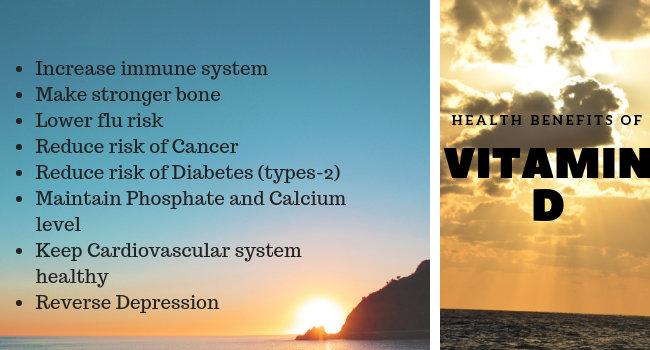Vitamin D – also known as a sunshine vitamin is one of the fat-soluble vitamins. This means that it can be stored for a longer period of time in our body.
Although it’s called a “vitamin” but it is essentially a hormone which gets activated after coming in contact with sunlight (or UVB rays to be specific).
Unlike other vitamins, which are required to be outsourced. Our body can produce its own vitamin D, but it requires again, the sunlight to do so.
This nutrient is very essential for a properly functioning system and optimal health. Not only does it helps in getting those bones strong and dense but new researches show that it also plays a role in the body’s immune system and is also instrumental in preventing certain types of cancer.
But unfortunately, the statistics paint a very atrocious picture. A substantial percentage of our world’s population is currently vitamin D deficient. Survey reports, it’s more than 40%! And that’s just an average combining all the ethnicities and geographical areas. That number increases drastically for people with dark skin and obesity.
In this article, we’re going to talk about as to why Vitamin D is important for a healthy life? As always, exploring different corners of it on the way.
What is Vitamin D ?

As we’ve already discussed in brief, vitamin D is a fat-soluble vitamin. It’s essentially a hormone because the activated form of this nutrient turns into a hormone called “calcitriol” (C27H44O3).
Unlike the other vitamins, this one can actually be synthesized by human beings. The requirement being – UVB rays (or in short the “sun”).
There are two types of vitamin D –
Vitamin D₂ (ergocalciferol) which is primarily found in plants (mainly in some types of mushrooms).
Vitamin D₃ (cholecalciferol) which is found in animals and its products i.e. egg yolk, fatty fish.
Out of the two, vitamin D₃ is much more effective and researches show that it’s twice as effective as the other one in increasing vitamin D value in the blood level.
Vitamin D isn’t typically sourced from our diet, or I should say it’s practically not possible to fulfill the adequate amount an individual needs via just our food. It’s the sun which is the primary “source”.
How Vitamin D is formed?
Unlike typical vitamins, vitamin D is unique and goes through multiple chemical processes before it can actually be metabolized by our system.
A little ago we discussed about the two different types of vitamin D. Among which our body can only synthesize the second one, which is found in animals – vitamin D₃.
When our skin is exposed to the sun, our body starts preparing vitamin D from the cholesterol present in our body. But before it can be metabolized by our body, it has to go through the hydroxylation process.
The first process takes place in the liver in which vitamin D-25-hydroxylase (25-OHase) is converted to 25(OH)D then further hydroxylation takes place in the kidney where 25(OH)D is converted to D 1,25(OH)2D (calcitriol) by 25(OH)D-1-OHase. Calcitriol is the final biologically active form of vitamin D.
Calcitriol can then incorporate with the vitamin D receptors (VDR) which are present in almost all the cells. It then plays with the genes turning it on and off.
Calcitriol stimulates the intestines to absorb more calcium and phosphorus, which would otherwise be wasted. It also then help contact with different cells.
And apart from the natural process, if one’s to take vitamin D from the mouth. The nutrient is first combined with chylomicrons and then absorbed into the lymphatic system which then disperses it into the bloodstream directly.
Also, read detailed in :
Health benefits of Vitamin D?
Vitamin D has many crucial roles to play in our human body. They are vital for a healthy and functioning system. It helps the immune system work properly and fight off infections efficiently.
It’s from long known that high bone strength and being out under sun had some correlation. And remarkably it’s the most significant role of vitamin D. It helps our body to absorb more calcium and phosphorus which in turns leads to higher bone strength and overall health.
Without which our kidneys would have just urinated out these useful and essential chemicals.
As it also helps boost the immune system, this reduces the risk of our body catching a flu.
Vitamin D has been found to help with pregnancy and infants. Mother with vitamin deficient was found to more likely develop a condition what we call “preeclampsia” which would then require a C section.
Infants who were dosed a good amount of this nutrient benefited a normal blood pressure, a healthy cardiovascular and overall system.
Vitamin D plays a very crucial role in cell recognition and communication. This is the reason why it has been found to help with different types of cancers by slowing down the cell multiplication.
This nutrient also has been found to benefit citizens by drastically lowering the risk of suffering from type 2 diabetes. Moreover, a good amount of vitamin D in the body has translated to the smooth functioning of the cardiovascular system, decreasing the risk of various cardiovascular diseases like asthma, hypertension, swine flu.
Vitamin D deficiency causes :
Vitamin D is essential for healthy bones and proper functioning of many internal processes. That’s why it is vital for a human being to get an adequate amount of it.
But there are several factors that can keep an individual from obtaining this critical component of nature. An obvious one is being under a roof all the time. Nowadays it’s not uncommon to stay inside one’s room and spend the whole day without wandering even a minute out. Everything we need is now accessible while staying in our house and internet facility has made it a lot easier to work from home.
According to the stats, more than 40% of the US population is vitamin D deficient. Now, that’s a lot of people (more emphasize on the word “lot’).
Skin color also plays a role in the amount of vitamin D an individual will get. The darker your skin color, the harder and more time consuming it will be to absorb the golden “sunshine”. The same is also true for obese people, the more fat you got, the harder it will be to benefit from the sunlight as fat can act as a layer stopping the rays.
Being old also makes it harder to synthesize the required vitamin D.
Sunscreen makes the condition worse; applying sunscreen can reduce up to 95% of the vitamin D production. Other circumstances like the time of the year and geographic location also play an important role in getting enough vitamin D.
One of the significant sign of suffering from a vitamin D deficiency is a condition called “rickets” in which the patient’s bone become extremely weak and softens up.
Symptoms of vitamin d deficiency in adults are:
- fatigue
- weakness and pain in bones
- pain in the muscle
- easy bruises
- poor wound healing
- increased infection
More serious ones are:
- diabetes
- obesity
- osteoporosis
- depression
- hypertension
Vitamin D rich foods :
The primary source of vitamin D is the sun, and we should strive to get the most amount of our required amount from the sun itself.
However, there are certain foods that contain vitamin D (mostly in a limited manner).
They are listed here:
- cod liver oil
- salmon, cooked
- fortified milk (skimmed)
- canned sardines
- cooked swordfish
- chicken
- eggs
Summary
Vitamin D is a fat-soluble vitamin that our body needs to function correctly.
Unlike other vitamins, our body can actually synthesize our own vitamin D from the cholesterol inside us via UVB rays of the sun.
There are two types of vitamin D – vitamin D₂ which is found in mushrooms and vitamin D₃ which is found in animals.
Before our body can benefit from this nutrient, it has to go through some chemical processes of what we call “hydroxylation”.
This nutrient is instrumental in having healthy and high strength bones. Along with that it also plays a role in our immune system helps prevent diabetes, slowdowns cancer in some cases and also prevents several cardiovascular diseases.
Nowadays, a significant amount of people are vitamin D deficient, due to lifestyle changes and other factors like skin color, weight, age. This can lead to several complications down the road.
A serious condition called “rickets” is a very well known cause of vitamin D deficiency.
NIH has issued some recommended intake allowances that can be followed by individuals. Though the requirement will vary a lot between individuals.
Lastly, the main source of vitamin D is sun and one should always try to obtain it from the sun itself. Other than that, there are certain food items that also contain the same but in a limited manner (except cod liver oil).

